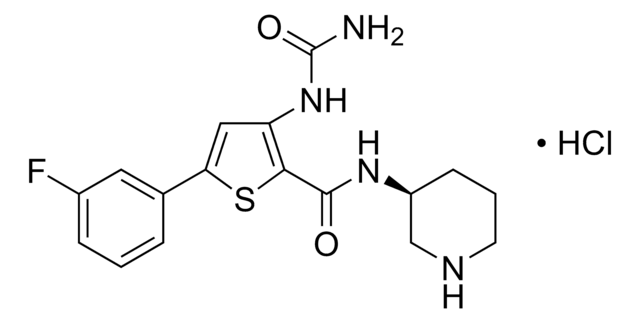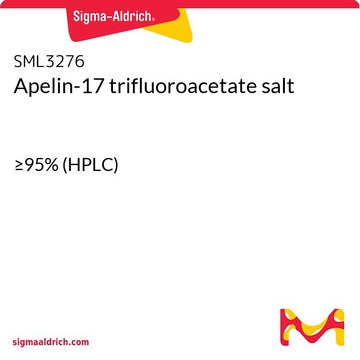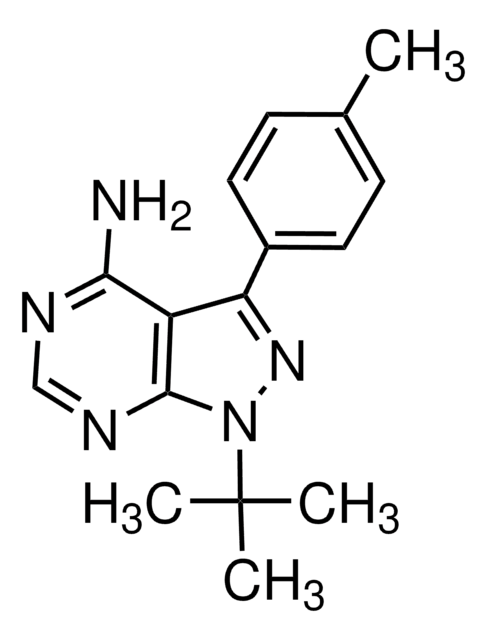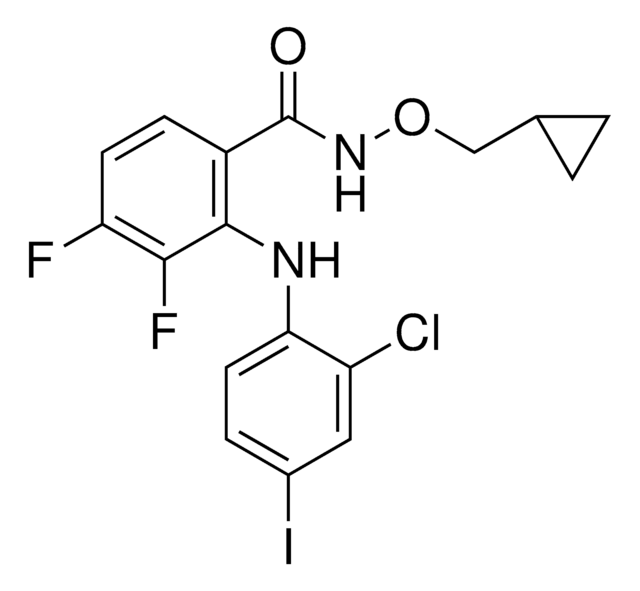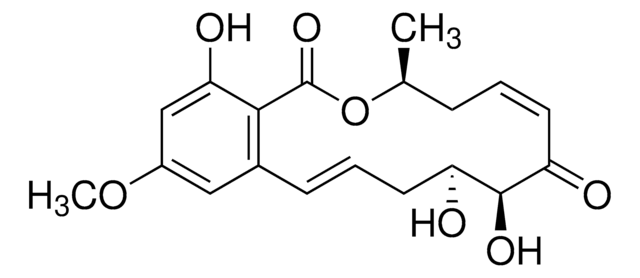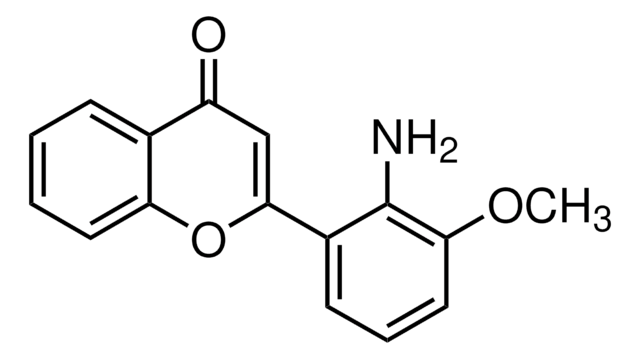SML2084
[Pyr1]-Apelin-13 trifluoroacetate salt
≥96% (HPLC)
Synonim(y):
5-Oxo-L-prolyl-L-arginyl-L-prolyl-L-arginyl-L-leucyl-L-seryl-L-histidyl-L-lysylglycyl-L-prolyl-L-methionyl-L-prolyl-L-phenylalanine TFA, Pyroglutamated apelin-13, Pyroglutaminated apelin-13, Pyroglutamyl apelin-13, [Glp1]-Apelin-13, [Pyr-1]-apelin-13, [Pyr]-apelin-13, [pGlu1]-apelin-13, pERPRLSHKGPMPF TFA, pGlu-Arg-Pro-Arg-Leu-Ser-His-Lys-Gly-Pro-Met-Pro-Phe, TFA
About This Item
Polecane produkty
Próba
≥96% (HPLC)
Formularz
powder
kolor
white to beige
Warunki transportu
wet ice
temp. przechowywania
−20°C
ciąg SMILES
S(CC[C@H](NC(=O)[C@H]3N(CCC3)C(=O)CNC(=O)[C@@H](NC(=O)[C@@H](NC(=O)[C@@H](NC(=O)[C@@H](NC(=O)[C@@H](NC(=O)[C@H]5N(CCC5)C(=O)[C@@H](NC(=O)[C@H]6NC(=O)CC6)CCCN\C(=N/[H])\N)CCCN\C(=N/[H])\N)CC(C)C)CO)Cc4nc[nH]c4)CCCCN)C(=O)N1[C@@H](CCC1)C(=O)N[C@@H](Cc2ccccc
InChI
1S/C69H108N22O16S/c1-39(2)32-47(85-57(96)43(17-9-26-76-68(71)72)82-63(102)52-20-12-29-90(52)65(104)45(18-10-27-77-69(73)74)83-58(97)44-22-23-54(93)80-44)59(98)88-50(37-92)61(100)86-48(34-41-35-75-38-79-41)60(99)81-42(16-7-8-25-70)56(95)78-36-55(94)89-28-11-19-51(89)62(101)84-46(24-31-108-3)66(105)91-30-13-21-53(91)64(103)87-49(67(106)107)33-40-14-5-4-6-15-40/h4-6,14-15,35,38-39,42-53,92H,7-13,16-34,36-37,70H2,1-3H3,(H,75,79)(H,78,95)(H,80,93)(H,81,99)(H,82,102)(H,83,97)(H,84,101)(H,85,96)(H,86,100)(H,87,103)(H,88,98)(H,106,107)(H4,71,72,76)(H4,73,74,77)/t42-,43-,44-,45-,46-,47-,48-,49-,50-,51-,52-,53-/m0/s1
Klucz InChI
GGMAXEWLXWJGSF-PEWBXTNBSA-N
Działania biochem./fizjol.
Kod klasy składowania
11 - Combustible Solids
Klasa zagrożenia wodnego (WGK)
WGK 3
Temperatura zapłonu (°F)
Not applicable
Temperatura zapłonu (°C)
Not applicable
Wybierz jedną z najnowszych wersji:
Certyfikaty analizy (CoA)
It looks like we've run into a problem, but you can still download Certificates of Analysis from our Dokumenty section.
Proszę o kontakt, jeśli potrzebna jest pomoc Obsługa Klienta
Masz już ten produkt?
Dokumenty związane z niedawno zakupionymi produktami zostały zamieszczone w Bibliotece dokumentów.
Nasz zespół naukowców ma doświadczenie we wszystkich obszarach badań, w tym w naukach przyrodniczych, materiałoznawstwie, syntezie chemicznej, chromatografii, analityce i wielu innych dziedzinach.
Skontaktuj się z zespołem ds. pomocy technicznej
![[Ala13]-Apelin-13 trifluoroacetate salt ≥96% (HPLC)](/deepweb/assets/sigmaaldrich/product/images/346/676/5f14b32d-4b38-4271-9545-b918d0021073/640/5f14b32d-4b38-4271-9545-b918d0021073.jpg)
